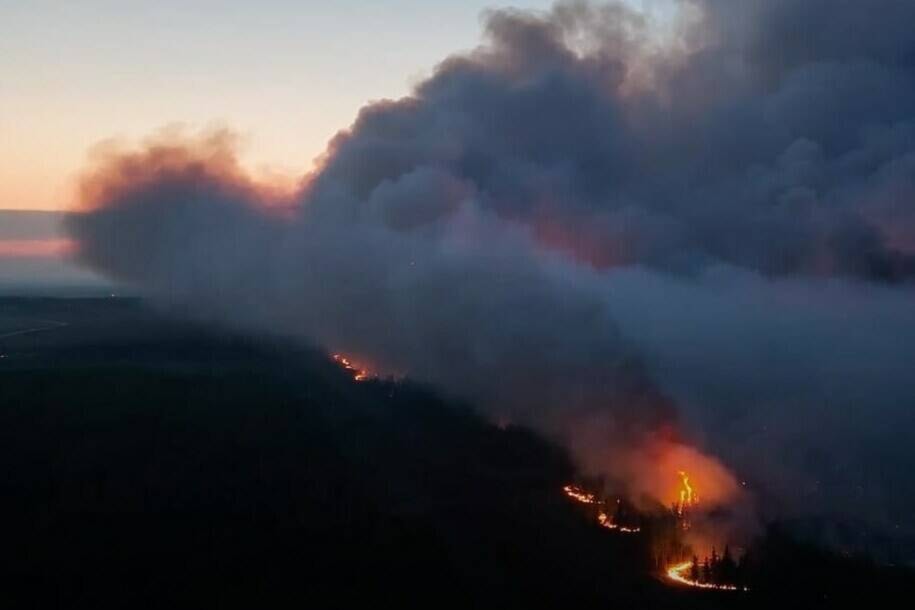Exceptional, summer-like conditions have dried out forest fuels in British Columbia, creating conditions that make some regions “highly susceptible to ignition and rapid spread,” the provincial wildfire service says in a status update Thursday.
The most significant wildfire activity has so far been concentrated in northeastern B.C., with the “vast majority” of ignitions attributed to human activity, it says.
Wildfires have charred more than 1,350 square kilometres of land in the province, eclipsing the area burned at the same time last year, as well as the 10-year average of about 120 square kilometres over the same time period, the service says.
Scattered thunderstorms were forecast throughout the central and southern Interior Thursday, along with moderate winds and variable amounts of rain.
The wildfire service says ignitions by lightning are possible given the hot and dry conditions, with the risk expected to extend into northern regions on Friday.
A transition to cooler, wetter weather is predicted starting Sunday, it says.
Outside Fort St. John, crews battling the 215-square-kilometre Stoddart Creek wildfire got some unexpected help in the fight.
Hannah Swift, an information officer with the BC Wildfire Service, said the amount of smoke in the area was enough to provide a buffer from the sun’s heat, which had been expected to cause problems for crews at that blaze and others nearby.
“That actually helps because the fire behaviour is not as active when it doesn’t have the direct solar heat on it,” Swift said in an interview on Thursday.
It was a happy medium, she said, because smoke had dissipated enough for the service to launch helicopters to support crews on the ground.
However, later Thursday, Swift told a briefing that low visibility from smoke meant firefighting aircraft had been grounded.
The fire burning about 25 kilometres from Fort St. John was not believed to have grown substantially over the last 24 hours, she said.
The city lifted an evacuation alert Wednesday that had put the community of about 21,000 residents on edge since Monday, while more than 1,300 properties in the surrounding area remain under an evacuation order.
The wildfire service’s website listed 63 active fires in B.C. on Thursday.
Fire information officer Paula Walbauer said crews were battling the 500-square-kilometre Donnie Creek fire between Fort St. John and Fort Nelson to the north.
A controlled burn was planned with the aim of preventing the fire from pushing any further south, she told a briefing on Thursday.
Other fires in the area have also grown, she said, and more heavy equipment and personnel were expected to arrive in the coming days.
The fire danger rating is listed as “extreme” for the northeastern corner of the province, where all four wildfires of note in B.C. are currently burning.
The danger rating is “high” for most of the rest of northern and central B.C., including the north and central coasts and patches of the southern Interior.
Open burning is prohibited across the province as of Thursday, and campfires are also set to be banned in the Prince George Fire Centre starting at noon on Friday. The area spans much of northeastern B.C., including Fort St. John.
The provincewide ban on Category 2 and 3 open burning includes fires with material in one or more piles not exceeding two metres in height and three metres in width, as well as burning stubble or grass that doesn’t exceed 0.2 hectares.
Campfires outside the Prince George Fire Centre must be confined to 0.5 metres in height and 0.5 metres in diameter, with water kept on hand to douse the flames.
“Open burning can be a useful tool when conducted responsibly and only while it is permitted. If conducted irresponsibly or in unsafe conditions, the potential of a human-caused wildfire increases,” the service said on Twitter last month.
READ MORE: Still smelling wildfire smoke? Stay inside or wear a mask, experts say
READ MORE: Helicopters and layer of smoke help in fight against northeastern B.C. wildfire
